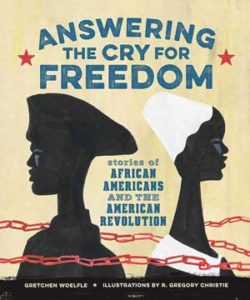Answering the Cry for Freedom
Reviewed by Paul Buckley
December 1, 2017
 Stories of African Americans and the American Revolution
Stories of African Americans and the American Revolution
By Gretchen Woelfle, illustrated by R. Gregory Christie. Calkins Creek, 2016. 240 pages. $18.95/hardcover; $9.99/eBook. Recommended for ages 9–12.
Buy from QuakerBooks
I’m writing this just after the Fourth of July, which has put me in mind of all the books I read as a boy on the American Revolution. They were stories of courageous heroes fighting for freedom. Nearly all were white (Crispus Attucks was the exception) and male (women were relegated to support roles for their husbands, brothers, and fathers). They were patriotic stories of manly fighters and fearless statesmen, and I loved it.
Answering the Cry for Freedom tells the stories of 13 African American men and women, slave and free, who lived in revolutionary times. These are also stories of courageous fighters, but they were fighting for a freedom that my childhood books rarely (if ever) recognized. Some of the same characters show up, but they fill very different roles. George Washington appears several times—mostly as a slaveholder—and Martha Washington as a woman aggrieved when a favored slave, Ona Judge, walks out of servitude. Thomas Jefferson is portrayed as taking advantage of an underage slave and barely acknowledging the children she bore. Among the white male heroes of my youth, only two foreigners, the Marquis de Lafayette and Tadeusz Kościuszko, really fare well. In this book, British generals and governors more often fill the roles of heroes who treated the African Americans under their protection fairly.
Even so, Answering the Cry for Freedom doesn’t just villainize some in order to build up others. It tells stories of flawed human beings, living in a different time and place, with both passion and compassion. The publisher identifies it as written for nine- to twelve-year-olds, but I loved it. It provides needed balance to the stories I read 50 or 60 years ago and introduces new American heroes. I think it would be wonderful to read in and discussed by a multigenerational group.
As a Quaker, I had another reaction to this book. Paul Cuffe (one of the 13 people profiled) was a committed member of the Religious Society of Friends. While he is described as a “deeply religious man,” the influence of his Quaker faith is only discussed briefly. Similarly, the chapter on Jarena Lee has a tangential mention of Quakers. Beyond these brief references, Quakers are absent. We prize our history as abolitionists and the fact that we took a corporate stand against the slave system long before any other denomination. And yet, Quakers play a very small part in the lives depicted.
Instead, nearly every chapter in this book reveals deep and enduring attachments to the Methodist Church—even in the chapter on Richard Allen who founded the first African Methodist Episcopal Church. In 1787, Allen protested segregation in worship and racial restrictions on preaching by leading a mass withdrawal of African American members from St. George’s Methodist Church in Philadelphia, Pa. They turned their backs on the Methodist Church, but not Methodism. More than a half-century later, white Methodists had still not taken a corporate stand against slavery. Their church split over the issue in the 1840s. I have to ask: why they didn’t turn to their allies, the Friends?
I think the answer is one that today’s Friends need to ponder. Quakers worked to free their bodies, but Methodists worked to feed their souls.



Comments on Friendsjournal.org may be used in the Forum of the print magazine and may be edited for length and clarity.